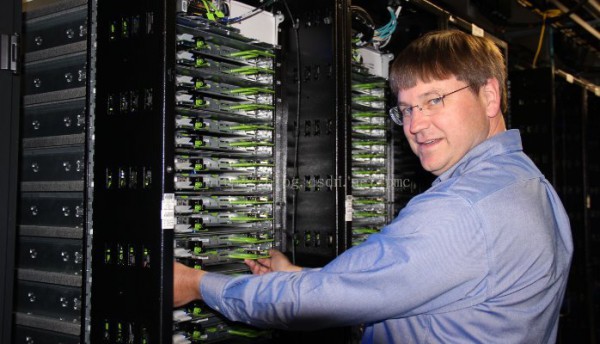Per Brasher

描繪某些個別公司熱中于對之夸大其詞的趨勢實在是太受人歡迎了。我的公司Yttibrium(Per Brasher是該公司的開創(chuàng)人,同時也是PMC的資深技術(shù)顧問)耗費了數(shù)周的時間,尋根究底,試圖為客戶描畫出1幅清晰的圖畫 。以下是針對今后幾年數(shù)據(jù)中心發(fā)展趨勢的若干核心預(yù)測。
尋求電能使用效力(PUE)最小化的時期1去不復(fù)返
由于美國能源署嚴(yán)格規(guī)定,任何取得國家科學(xué)基金的項目必須保持PUE在1.4乃至更高水平,而ASHRAE (美國采暖、制冷與空調(diào)工程師學(xué)會)TC9.條令則建議城市PUE值保持在1.2或更高,幾近所有的建筑公司要末是找到了切實方法,要末是把數(shù)據(jù)“洗綠”了以滿足這些需求。如果你還不了解該計算程式的漏洞所在,只需想想,若是在系統(tǒng)中加上效力顯著提升的IT負(fù)載會怎樣樣…哦?!明顯,發(fā)明這個方程的目的并不是意在中斷IT負(fù)載層面的任何創(chuàng)新?!
轉(zhuǎn)向機架級別的解決方案
愈來愈多的機架在遠址構(gòu)建,1旦運至數(shù)據(jù)中心,只需“分分鐘”就能夠設(shè)置好。許多廠商都將其吹噓成軟件定義的數(shù)據(jù)中心(SDDC),但實際上,遠址集成、常規(guī)測試、穩(wěn)定性老化測試等所節(jié)省的本錢開支非常客觀。企業(yè)還沒有積極地?fù)肀н@1軟件定義的理念,主要緣由是本錢/風(fēng)險的計算還不太明確。但機架級的解決方案在本錢和風(fēng)險兩方面的優(yōu)勢均10分顯著。因此,可以預(yù)計,待解決方案供應(yīng)商們醒過勁兒后,對機架級產(chǎn)品的需求將大幅度爬升。
基于POD的設(shè)計
我避免稱其為“模塊化”或“容器化”的設(shè)計,緣由在于有些解決方案利用了空置的倉庫,在中間擺放1個容載系統(tǒng);另外一些則成排構(gòu)建,在后門或走道旁放上散熱片;還有些公司則把全部建筑拿來使用。數(shù)據(jù)中心系統(tǒng)的建設(shè)正趨向于:消除過去巨大的前期1次性的基礎(chǔ)設(shè)施的建設(shè)投資,隨著自己業(yè)務(wù)增長而逐漸購買、擴建數(shù)據(jù)中心裝備。從基礎(chǔ)設(shè)施的角度來看,任何部件都可以預(yù)先設(shè)計,再在部署時進行按需復(fù)制。一樣地,下降風(fēng)險與本錢自然有其優(yōu)勢,因此,預(yù)計這個領(lǐng)域也會有快速的增長。
低能耗密度的解決方案是王道
隨著經(jīng)濟實用成了慣常的考量標(biāo)準(zhǔn),而提供的方案的溫度卻延續(xù)提升,散熱能力就成了管理中的重要因素。DCiM工具與利用負(fù)載的集成尚有欠缺,尚不理想,因此,就有賴于從密度的角度來下降能耗。由于多數(shù)時候,訪問速度并不是相當(dāng)重要,所以將會看到數(shù)據(jù)中心的建筑從城市中心區(qū)域向郊區(qū)轉(zhuǎn)移的趨勢,從而減緩了采用50+U的機架或高密度計算的壓力。
氣流方面的優(yōu)化對全球60%可用地點均行之有效
選擇干燥溫暖的地方還是溫暖濕潤的地方?這是個辣手的問題。但是除用水這1塊的節(jié)能裝置的額外開消,還需要巨大的儲水罐來晝夜下降水溫,這些都會增加整體本錢,而對風(fēng)險控制并沒有補益。根據(jù)其設(shè)計說明,所有IT裝備(除磁帶之外)都可適用于兩種系統(tǒng)。另外,也有云和COLO供應(yīng)商在力圖獲得額外的本錢節(jié)儉(既能下降構(gòu)建本錢,也能減少運營本錢)。
SAS將會成為經(jīng)常使用的存儲網(wǎng)絡(luò)
連接在SAS“網(wǎng)格”上的SATA終端愈來愈常見。其技術(shù)挑戰(zhàn)在于,當(dāng)為SATA建立隧道傳送數(shù)據(jù)時,不同速率的端點(磁盤)會阻礙其它端點的通訊。因此我們把這些看成微型網(wǎng)絡(luò),可支持多種簡化/局限的利用場景:例如保護倒換來實現(xiàn)高可靠性,或簡單的同享和提高可靠性的機制。事實證明,將硬盤從服務(wù)器機架上取出并置于獨立的外殼內(nèi)確有其好處(下降了EMI,從而延長了其使用壽命),一樣也改良了其服務(wù)效力(速度更快,無需工具便可進行替換),但是卻缺少任何網(wǎng)絡(luò)智能。
值得關(guān)注的技術(shù)趨勢
HDD-> SMR
DRAM-> NVDiMM
IA-> SOC
Tape-> BluRay
NVMe/ PCIE Gen4 得到強勢推動
Data Center Trends
It was incredibly popular to write abouttrends that one or another company thought reasonable to self aggrandize about.Yttibrium spent literally weeks sifting through all the mud to get a clearpicture for our clients. Here is our top pick for the coming year(s).
The Race for a Low PUE is Over
With the DOE having mandated anyonegetting NSF funds must have a PUE of 1.4 or better, and ASHRAE TC9.9 havingmade the recommendation that municipalities require a PUE of 1.2 or better(good option to get more revenue if you ask me..tax the wasters!) Almost everybuilder out there has either created anoffering, or found a way to 'green wash' the numbers to meet the needs. If youare not familiar with the faultiness of the formula, just think what happens tothe overall number when you put in significantly more efficient IT load.. oops,that is not the intention of the formula, to stop innovation at the IT loadlevel.
Move to Rack Scale Solutions
Racks are more and more being builtoff-site and once rolled into the DC, provisioned in 'minutes'. Many vendorstout this as SDDC, but in reality the cost savings of off-site integrators,test and burn in before the equipment hist the floor is compelling. Enterpriseshave been slow to adopt much of the SD* due mostly to an unclear cost/riskcalculation, but with Rack Scale Solutions having both lower cost and lowerrisk, expect to see the demand rise significantly as solutions providers wakeup.
POD Based Designs
I avoid calling them 'Modular' or'Containerized' because some solutions use empty warehouse spaces, and plop acontainment system in the middle, and others build a row, put cooling fins onthe rear doors or over the isle, and even some build the whole building likethis. Point being the trend to sale as you grow Data Center systems haseliminated the huge up-front costs we saw in the past. Now everything from theinfrastructure point of view can be predesigned, and copy-paste deployment style.Again lowered risk, and lowered cost has it effect, so expect to see rapidadoption in this space as well.
Low Power Density Solutions Dominate
As economizers are becoming the norm,and the supply side temperatures are being raised, the ability to cool becomesa critical element to manage. DCiM tools are not up-to-snuff yet, with a lackof integration with app loads, so we look to the density question to reducerisk. Since most access speeds are not critically important, look to see thebuildings trend away from the metropolitan districts in favor of a suburbanspace. this releases the pressure to go to 50+ U racks and high densitycompute, after all, "land is cheap outside Boise ID".
Airside Economizers Work for 60% of Potential Sites World Wide
The choice of warm and dry vs. warm andwet is a real battle, but with the added losses of the waterside economizer,huge storage tanks are needed to cool the water over night, and use it duringthe day. That makes the overall cost rise, but does little to reduce risk.
SAS will Become the Storage Network
SATA endpoints on a SAS 'fabric' isbecoming more popular. Challenge is when tunneling SATA, endpoints of differingspeeds, can bugger up things for the others. So we see these as micro nets,allowing a very reduced use-case, like HA fail-over, or other simpleavailability/sharing needs. The trend to take the drives off of the serverchassis and into their own enclosure has proven better for the drives (loweredEMI etc. makes them live longer) and for service (faster and tool-less swap),but left us wanting for just a little touch of network intelligence.
Technologies to Watch
HDD-> SMR
DRAM-> NVDiMM
IA-> SOC
Tape-> BluRay
NVMe/ PCIE Gen4 getting a needed shot of steroids
Sensors in the DC, BigData will start to run the DC
